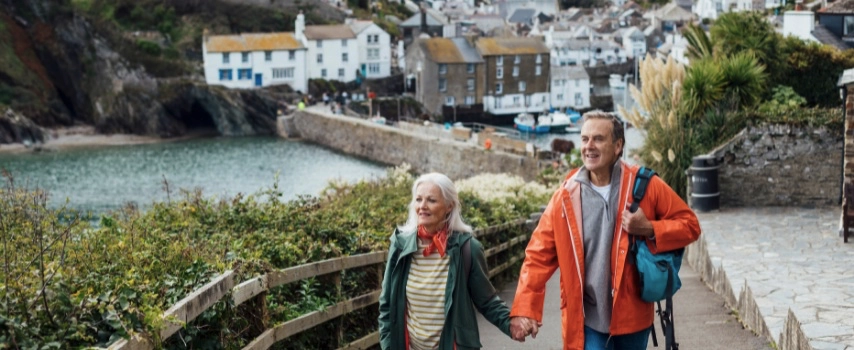Ultimate Travel Guide: UK and Europe Travel Tips

Holiday hacks and top Europe travel tips for your upcoming trip
Planning a European holiday or a visit to the UK? Whether you’re planning on travelling to London from Australia or landing in one of Europe’s many beautiful capital cities, you’ll be spoilt for choices when planning your itinerary.
Whether it’s your first visit or your 10th, it’s always helpful to read UK travel guides and Europe travel tips before you book. From what you need to pack, what currencies you’ll need, and what travel scams to look out for, there’s always something to learn.
Below, you’ll find our best holiday advice for trips to the UK and Europe to help you travel safer, smarter, and with confidence.
Want us by your side as you travel abroad? You can learn more about our travel insurance cover for the UK and Europe here, and you can get a quote online now, too.
Skip ahead to read:
- What’s the best way to get around Europe and the UK?
- When is the best time to travel to Europe and the UK?
- Do I need travel vaccinations before I travel to Europe and the UK?
- What currency is used in Europe and the UK?
- Is it easy to access Wi-Fi in Europe and the UK?
- What power adaptors are used for Europe and the UK?
- Do I need to speak the local languages to travel in Europe?
- How can I avoid culture shock in Europe?
- Is it safe to solo travel through Europe?
- Should I join a group tour when travelling in Europe?
- 8 essential UK and Europe travel tips you need to know
- 4 common tourist scams to avoid
- 6 best places to visit in Europe
What is the best way to get around Europe and the UK?
Australian travellers generally find it easy to get around Europe and the United Kingdom.
Both destinations have many transport options from high-speed trains, buses, and ferries to a range of airlines that can help you travel from country to country within a short amount of time. Yes, unlike in Australia, it’s actually possible to have an English breakfast in London and then a long lunch in Paris. You could even plan for a dinner in Brussels afterwards if you want!
Whatever you want to fit into your itinerary, we recommend you pre-plan your transport options before embarking on your journey. Sites like Rome2Rio and Skyscanner are helpful for finding the best route – and price – for your UK and Euro trip.
If you buy tickets online, most countries offer electronic tickets for transport, however, not all will have adopted this system so be sure to double check. In some European countries, train tickets need to be validated before boarding the train. To avoid a fine, get your train ticket stamped by the machines at the platform.
Wi-Fi is offered on some British and European trains; however, you may need to pay for access on some routes.
Want more European transport travel tips? Read our How to get around Europe travel guide.
When is the best time to travel to Europe and the UK?
Like the majority of Australia, there are four seasons in Europe. However, because the UK and Europe are in the Northern Hemisphere, both destinations experience opposite seasons to us.
During the summer months (June to August), Europe experiences a peak travel period as tourists flock to soak up the sun. For holiday ideas, discover our 10 best European summer destinations here.
Travelling to the UK and Europe during the shoulder months of spring and autumn may have fewer crowds and more affordable accommodation options. Plus, both destinations are beautiful during these times thanks to the blooming flowers and colourful leaves, so are definitely worth considering.
Winter is also a beautiful time to visit the UK and Europe. Whether you’re an avid skier or snowboarder, or simply wish to spend hours exploring the Christmas markets and experience a white Christmas, a winter trip can provide a magical backdrop for your travel memories. To find the best European cities to visit during the colder months, read this.
Seasons in Europe and the UK:

Thinking about skiing or snowboarding while you’re on your European holiday? Here’s what you need to know about our Snow Sports Cover.
What travel vaccinations do I need for Europe and the UK?
When planning to travel overseas, you should consult your GP or visit a travel doctor to find out what vaccinations you need.
Most European countries are developed and have a lower risk of infectious diseases for travellers when compared to other areas, such as parts of South America or Africa.
Travellers to the UK and Europe generally only require routine vaccinations or boosters to help protect against illnesses such as Hepatitis A, tetanus, and the measles.
Be sure to visit your doctor prior to travelling so you can discuss with them what immunisations you should have before your holiday – and when you need to have them.
If you want to help protect yourself against the cost of overseas emergency medical expenses, while you’re in the UK and Europe, we can help. Get a free quote for our Cover-More travel insurance here to find out how affordable cover can be.
What currency is used in Europe and the UK?
In the United Kingdom – consisting of England, Scotland, Wales, and Northern Ireland – the main currency is Pound sterling (£). You may notice the notes are different in Scotland than elsewhere in the UK, but they are all Pound sterling and can be used anywhere within Great Britain.
The main currency accepted in Europe are Euros (€), however, some European countries use their own currency. For example, Poland has Polish złoty, Croatia has Croatian kuna, and the Czech Republic uses Czech koruna. If you are visiting smaller European countries that have their own currency, you may be able to pay for items using Euros, but you may end up paying more as a result.
We recommend you research your specific holiday destinations to find out what currency is used in the places you plan to visit to you can plan to get the local currency upon arrival or organise a travel card with the currency pre-loaded.
Did you know: our travel insurance can provide cover for the money you carry on you while travelling in the UK and Europe if its lost or stolen off your person.
To protect your trip with our travel insurance, you can get a free quote online now – just be sure to read the PDS to understand if our product is right for you and your trip.

Is it easy to access Wi-Fi in Europe?
Good news for jetsetters who want to stay connected while on the road away from home: Wi-Fi in Europe and the United Kingdom is easily accessible. You can tap into Wi-Fi at most hotels or hostels, and you can also connect while dining at many restaurants and bars. If the access details aren’t already available on the menus or signage, all you need to do is politely ask if you can use it and they will likely provide you with access details.
Don’t want to rely on public Wi-Fi? Get access to your own data on the run by picking up a local sim card at the airport or local newsagencies and corner stores. Many UK and European pre-paid providers will allow you to use your data across the continent, so you won’t need to buy a new sim card in each country.
What power adaptors are used in Europe and the UK?
Are you travelling to the UK or Europe and taking your Australian appliances and electronics with you? Don’t forget you’ll need to pack the right power adaptor to use and recharge them.
In Europe, you’ll need the “Europlug”. It is one of the most common plugs in the world and has two round prongs. Almost all European countries – such as Italy, Germany, and France – use the “Europlug”, so you’ll likely only need the one adapter in across the continent.
In the United Kingdom (England, Wales, Scotland, and Northern Ireland) and the Republic of Ireland, you’ll need the UK plug. It consists of three prongs in a triangular shape, but is different to the Australian three-prong plug.
We recommend you research the correct plug for all countries you’re visiting before you leave home to ensure you’re packing the right type of adaptor for your holiday.
You can find out more about the power supply in Europe and the UK here.
Do I need to speak the local languages to travel in Europe?
If you’re nervous about not speaking any of the local languages in Europe, the good news is you can get by in most popular tourist destinations using English – whether it’s reading signs in English or speaking to locals in English.
However, it’s always a good idea to brush up on some local phrases or words as a sign of respect. Even if your pronunciation isn’t perfect, the locals will appreciate you trying to communicate with them in their native tongue.
Top Europe travel tip: download a translation app.
If you’re travelling to destinations less frequented by travellers, you may find it harder to communicate in English. Thankfully, there are many great translation apps – like Google Translate – that you can use on your travels, from translating menus or transport information to aiding conversations with the locals.
How can I avoid culture shock in Europe?
Travelling to new destinations and experiencing another culture is all part of the fun of travelling. However, sometimes being in a completely new place can be overwhelming.
When you travel to London from Australia, you’ll likely feel somewhat at home because the British speak English, drive on the left side of the road, and share several cultural similarities with Australians.
That said, there are several cultural differences between Australia and many European countries. For example, most European countries have their own local languages, they drive on the righthand side of the road, they often smoke cigarettes – including inside restaurants and bars – and they may not be as punctual as Australians.
Yes, in places like Spain and Southern Italy, life is a little more laid back – and the concept of time a little looser – so try to keep a flexible schedule as you may find your bus or train arrives much later than its scheduled time.
You’ll want to remember many European countries embrace siestas, too. Thanks to this scheduled afternoon nap, the open hours of stores, museums and other attractions may be affected.
While out exploring in Europe, you may be required to pay a small fee to use a public toilet via a coin-operated entrance gate or directly to a bathroom attendant. Some toilets aren’t always well stocked with toilet paper, so it’s wise to carry pocket-size tissue packs just in case.
Top Europe travel tip: look for signs showing ‘WC’ if you need the toilet.
WC stands for ‘water closet’ and means there is a toilet behind the door. It’s also helpful to learn the word for toilet in the local language so if you cannot see a WC, you can seek help from a local.

Is it safe to solo travel through Europe?
Travelling to a new destination can be exciting, and even more exhilarating if you’re doing it on your own. Solo travel gives you the flexibility to do whatever and go wherever you want all while opening your mind, increasing your self-confidence, and challenging your ideas and expectations.
If you have never done a solo trip but are dreaming of being a solo traveller, Europe and the UK are great destinations to visit. Both places are easy to get around, there are many accommodation options designed for solo travellers such as hostel, and you’ll no doubt cross paths with friendly travellers – even other solo travellers – on your trip.
Just don’t forget to keep your smarts about you while you’re out and about, keep in regular contact with friends and family back home, and plan ahead so you know where you’ll be spending each night ahead of time. For more tips from a seasoned traveller on how to plan for a solo trip, read this.
Should I join a group tour when travelling in Europe?
Although travelling solo allows you to have complete freedom and independence, it can be a little daunting. Travelling in the UK and Europe with a tour group can give you extra peace of mind as a solo traveller, as everything is organised for you, and you’ll be spending time with other likeminded travellers. Plus, there is safety in numbers, so having a bunch of travel buddies can mean you don’t end up getting lost on your own.
Travelling with others? Group tours in Europe and the UK aren’t only a great choice for solo travellers – they’re great for couples or groups who don’t want to put hours and hours into researching a destination or want the extra security of a guide who speaks the local language. Tour guides often share insights and take you on experiences only a local knows, helping to create unique travel experiences.
8 essential UK and Europe travel tips you need to nnow
Planning an overseas trip can be quite stressful, so here are some helpful Europe travel tips to ensure you know the essentials before you’ve even begun to pack your bags:
- Tip #1: Ensure your passport is valid for at least six months from the date you plan to come back to Australia.
- Tip #2: Even though Australian citizens do not usually need a visa to holiday in countries in the Schengen area for up to 90 days, be sure to check the visa requirements for all countries you’re travelling to in the UK and Europe, including non-Schengen European countries.
- Tip #3: Always carry your passport on you when crossing country borders in the UK and Europe by bus, train, or car, even if you are staying within the Schengen area.
- Tip #4: Share your itinerary with family or friends before you leave, and register your travel plans with DFAT via smartraveller.gov.au, as they can assist with contacting you or your relatives in an emergency.
- Tip #5: Be aware that Europe and the United Kingdom can experience natural disasters such as flooding, blizzards, avalanches, strong winds, and storms. If you experience an event while you’re there, always follow the advice of law enforcement to stay safe.
- Tip #6: Use a pre-travel checklist to tick off tasks you need to do before you depart – such as notifying your bank that you’ll be overseas to emptying your refrigerator.
- Tip #7: Consider protecting your trip with travel insurance. You can compare our Cover-More plans online, read the PDS for all the details you need to know before purchasing, and get a free quote online.
- Tip #8: Check out our travel alerts for our latest advice about world events that may affect your trip and/or claims if you’re a Cover-More customer.

4 common travel scams in Europe and the UK
Tourist scams occur all over the world, but one of our top UK and Europe travel tips is being aware of common travel scams so you’re less likely to fall victim to one.
Here are four common travel scams so you know what to look out for while you’re abroad:
1. The “friendship” bracelet.
This travel scam often occurs when a person approaches you and ties a friendship bracelet around your wrist, claiming it’s a token of friendship. Although insisting “it’s free”, the opportunists around you will then try picking your pockets while you are distracted. Always remember to protect your valuables and excuse yourself firmly.
2. The “found” ring.
This tourist scam is when someone nearby picks up a ring from the ground and asks if you’ve dropped it. When you say no, the person looks closely at the ring and states it’s pure gold. They will then offer to sell it to you for a “good” price – but there’s no doubt you’ll be getting ripped off.
3. The “helpful” local.
Tourists can look confused as they’re navigating a new city, and as a result, unknowingly become a prime target of the “helpful” local. This travel scam involves someone coming up to you and offering to help you buy your train tickets or walk you to where you’re wanting to go. You may think they’re being a good Samaritan, but don’t be fooled – they will demand some cash in exchange for their help.
4. The sneaky street performer.
Be cautious of those dressed in costumes or performing a unique trick on the street. You can watch the performers all you want but avoid taking a photo of them or with them – unless you want to pay up. Often, these types of tourist scammers will demand payment from you for the photo and problems can occur if you refuse or even try to delete the photos.
Discover other travel scams you should avoid here.

6 of the best places to visit in Europe and the UK
Europe and the United Kingdom are home to countless destinations worth exploring. However, sometimes having too many brilliant options can lead to overwhelm.
Below, we’ve gathered our top six cities to explore across Europe and the UK whether you’re a first-time traveller or a frequent visitor to this side of the world.
1. London, England
London is a diverse and multi-cultural city that provides visitors with some of the world’s best sights and attractions. A ride on the famous London Eye will take your breath away with its spectacular 360-degree views of the capital and its famous landmarks, while you won’t want to miss other London icons such as Big Ben, the Tower Bridge, Buckingham Palace, the vibrant West End, and Hyde Park to name a few.
If you’re looking to sightsee, you can jump aboard the “Hop On, Hop Off” bus tour, where a 24-hour ticket will give you unlimited travel around London for the day. Or, if you’re confident using public transport, the Underground (or The Tube, as locals call it) is easy to use, reliable, and has stops all over the city.
2. Paris, France
Commonly referred to as the City of Lights, Paris will steal your heart with its magnificent views, food, and trendy fashion.
While you’re there, you can visit the iconic Eiffel Tower during the day and the watch on from afar as its golden lights sparkling every hour on the hour at night-time; you can head over to the Louvre Museum and view the crowd-drawing Mona Lisa painting; and you can also wander past the Notre Dame, the Champs-Élysées, and Arc de Triomphe to round-out your Parisian city experience.
If you’ve got time to leave the city centre, the Palace of Versailles is one for the bucket list.
Want more Paris travel ideas? Check out this blog by Jessica Valentine from Flying the Nest.
3. Rome, Italy
There’s always something to see, do and eat in Rome! When visiting this beautiful ancient city, why not step into the Colosseum – the site of many battles that once held approximately 50,000 spectators.
You should also visit one of Rome’s ancient masterpieces, the Trevi Fountain, where it’s tradition to throw a coin into the water with your right hand over your left shoulder and make a wish.
For the wine-lovers who have a little extra time on their hands, experiencing the beautiful wine country in Tuscany whether it’s on a day trip or an overnight stay is a must-do.
Travelling to Rome for the first time? Read our expert travel blogger’s guide to Italy’s capital.
4. Berlin, Germany
Germany is an incredibly country to visit thanks to its beautiful landscapes and fairy tale castles, but one of the country’s jewels is its capital, Berlin. While you’re in this historical city, you can stroll between iconic landmarks like the Brandenburg Gate, Berlin Cathedral, and various sections of the Berlin Wall. The Berlin Wall Memorial and the East Side Gallery are a must-visit for many tourists to Berlin, and – if you’ve got time – it’s worth taking a train ride outside of the city to explore Charlottenburg Palace.
Check out our article on the must-see places in Berlin for more inspiration on how to spend your time in the German capital.
5. Barcelona, Spain
Want to indulge your senses with sangria and tapas along the sun-kissed beaches of Barcelona? Visit this beautiful Spanish city and you’ll experience more than sea, sun, and snacks…
You can take your time strolling around the Park Güell and take in impressive gardens, architecture and views of the city, head over to the famous Sagrada Família to see the spectacular yet unfinished work of Antoni Gaudí, and finish up with a walk down the striking tree-lined La Rambla.
Want to scrub up on your Spanish before you visit? Here are some useful Spanish words to help you converse with the locals.
6. Dubrovnik, Croatia
With glorious turquoise waters, character-filled cobblestone streets, and an Old Town with beautiful architecture, Dubrovnik is one of Croatia’s best cities.
While visiting, you can enjoy a cable car ride up the mountain to take in stunning views of the ancient city and its surroundings – and even have a meal or drink at the restaurant at the top of the hill.
For more striking views, take a walk along the Dubrovnik City Walls. These medieval walls were originally built around the seashore to protect the town from pirates and unwelcome guests, but fast forward to today, they’re key attraction in Dubrovnik – and a top destination for Game of Thrones fans, too.
Keen to explore this beautiful city? Check out our video below of Dubrovnik from Stephen and Jess at Flying The Nest.
Ready to book your European holiday?
Safeguard your getaway with our international travel insurance.
Material on this website is provided for informational purposes only. It is general information and discussion about medicine, health and related subjects may not apply to you as an individual and is not a substitute for your own doctor’s medical care or advice. The words and other content provided on this website, and in any linked materials, are not intended and should not be construed as medical advice. If the reader or any other person has a medical concern, they should consult with an appropriately licensed physician or other health care worker. Nothing contained on the website is intended to establish a physician-patient relationship, to replace the services of a trained physician or health care professional, or otherwise to be a substitute for professional medical advice, diagnosis, or treatment. The views and opinions expressed on this website have no relation to those of any academic, hospital, practice or other institution with which the authors are affiliated. They do not necessarily reflect the opinions of Cover-More Insurance Services Pty Ltd. Never disregard medical advice or delay seeking medical care because of something you have read on or accessed through this website. If you think you may have a medical emergency, call your doctor or emergency services immediately.